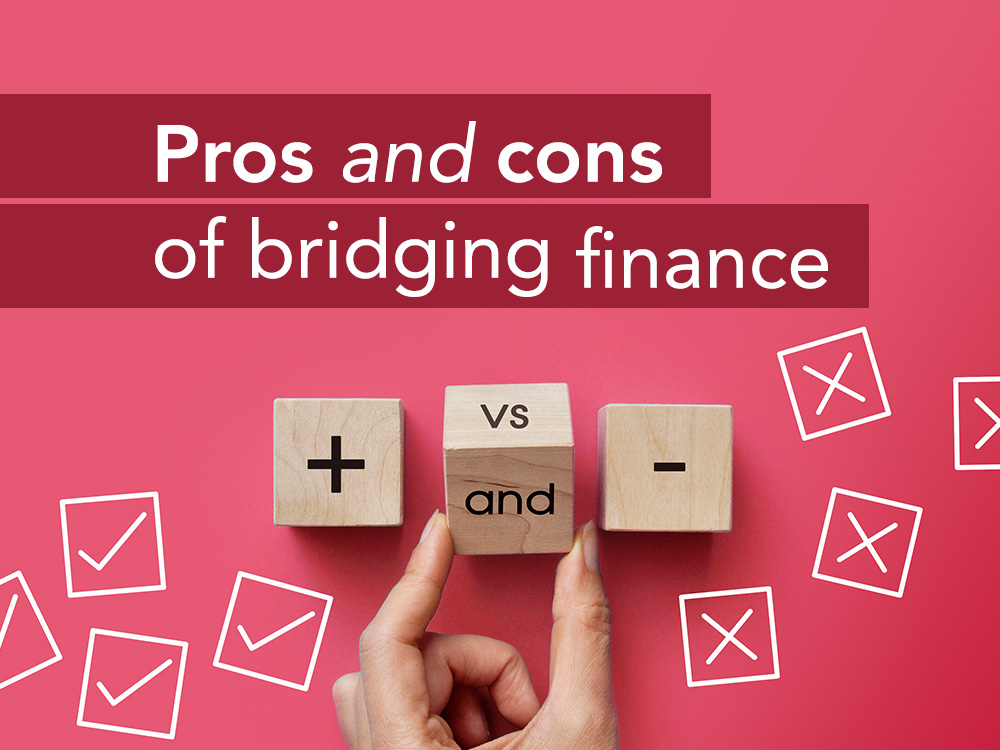Pros and cons of bridging finance
The dramatic increase in bridging finance over recent years has opened many investors’ eyes to the benefits of the sector. Nevertheless, it’s not the ideal solution for everyone.
Here is a straightforward guide to the pros and cons of bridging finance.

Advantages of bridging finance
Speed is the number one attribute for many bridging finance borrowers. They are keen to conclude a property transaction and risk losing the deal if they cannot move quickly.
Speed is often the priority, even outside of property transactions. For example, when a large and unexpected bill falls due, or an inheritance tax demand emerges following the death of a relative.
Instead of lengthy and complex negotiations with lenders to determine borrowing criteria, bridging finance companies can typically reach a decision in days, forwarding funds to meet urgent requirements.
This attribute is particularly helpful if you’re looking to buy a property at auction, where funds have to be released within a few days of an agreed purchase. Banks and building societies are not generally able to agree a mortgage sufficiently quickly for auction buyers.
Further down the line, when a borrower has had a bridging finance arrangement, they may wish to extend it or amend the terms in some way. Once again, these arrangements can be made at speed, saving the borrower the time and expense of lengthy and complex discussions.
Flexibility is another attribute which helps persuade borrowers to take out bridging finance. There are typically no financial penalties for early repayment, in contrast with many products offered by traditional lenders such as High Street banks and building societies. Bridging finance deals can be amended to incorporate new assets, to be extended in scope or in time, or to change the way in which interest is calculated. This is particularly helpful for property developers, for example, who can borrow varying amounts depending on their projects' status and their assets' valuation.
The short-term nature of bridging finance means that borrowers are not saddled with multiple years of debt, weighing on them and their businesses or families. Bridging finance enables fast, convenient transactions.
Borrowers can roll up the interest they owe and repay it all at the end of the contract (typically when they have sold an asset), meaning that they do not need to make any interim payments, thereby freeing up cashflow.
Availability. In many cases, bridging finance is available for investments, developments and purchases that traditional lenders are reluctant to cover or refuse completely. This situation has grown more acute over the past 20 years, as banks and building societies (and the UK government) reacted to the excesses of the early 2000s and the consequent credit crunch of 2008 by restricting their activities and making their lending criteria more onerous.
Whereas in the late 20th century, borrowers could ‘self-certify’ their income and assets, new laws meant that lenders had to conduct more rigorous due diligence into affordability, to prevent borrowers from taking on too much debt. Separate regulations restricted access to buy-to-let mortgages.
Bridging finance companies are not limited by these restrictions, meaning that they can extend credit to borrowers irrespective of their financial situations and the purpose of their loans – presuming only that they have an asset against which to set their borrowing.
Bridging finance is also available to those known as non-status, that is where a borrower has a sparse credit history or even no credit history at all. Equally, adverse or bad credit won’t prevent a borrower from obtaining bridging finance. This type of finance is also open to UK residents, ex-pats and foreign nationals.
Property condition. Banks and building societies are limited in the types and conditions of properties that they can lend against. For example, it is harder to get a mortgage for an uninhabitable dwelling, or to convert an office into apartments. Bridging finance companies have fewer limitations, making them ideal sources of funding for unconventional or challenging development projects.
Variety of providers. Since the explosion of demand for bridging finance in the 21st century, a great many new providers have emerged, creating competition in the sector which has lowered interest rates charged to borrowers and increased the number and variety of products offered. This has meant that the difference between the interest rates charged by traditional lenders and by bridging finance companies has narrowed, to the benefit of borrowers.
Size of loan. In contrast to mortgages, which are calculated according to a borrower’s income and expenses, bridging finance is worked out solely in terms of asset value. Many UK property owners have properties worth over £800,000, even though they earn less than £80,000 a year. Whereas a bank might offer them a mortgage of £300,000, a bridging finance company could offer up to £600,000. And if the asset you own is worth millions of pounds, a bridging finance company could loan you a very large sum – far above anything that a traditional bank or building society could offer.
Consistency. Whereas High Street banks and building societies will typically raise their mortgage rates in response to changes in the Bank of England base rate, bridging finance companies usually agree a rate at the start of a contract and maintain this rate through the lifetime of the loan, giving the borrower more security over its total cost.
Cons
High interest rates are cited as the most obvious disadvantage to bridging finance. Whereas traditional mortgage lenders will charge interest of around 5 per cent per annum, bridging lenders may charge anything from 10 to 20 per cent per annum. This higher fee reflects the additional risk that they take, in case a borrower defaults for some reason, and the fact that they do not rely upon the strength of a borrower’s financial circumstances. If a bridging finance contract extends for longer than anticipated, these high interest rates can become a serious liability.
Additional fees. Besides the interest rate charged for bridging finance, borrowers typically need to pay an arrangement fee of around 2 per cent of the total, along with administration fees, processing fees, legal fees, valuation fees, broker fees and completion fees. These additional expenses need to be factored into the deal: they may end up costing a borrower much more than alternative sources of funding, making bridging finance unaffordable or onerous.
There have been recent examples of bridging finance companies who have failed to disclose payments made to brokers, in breach of regulations. You need to be confident that a bridging finance broker is working on your behalf, rather than trying to sell you a product because it will benefit them financially.
Tax implications. Buying another residential property before you’ve sold your existing home has several advantages, including the absence of a chain, which reduces stress and means the transaction progresses more quickly. However, if you own both properties at the same time, the new one is treated as a second home by HMRC, attracting a higher rate of Stamp Duty Land Tax (SDLT).
As long as you sell your original property within three years and apply for a rebate within 12 months of buying the new one, you can reclaim the additional tax that you’ve paid. But it does leave you with less cash in the short term and you need to plan for these payments in your budgeting.
Risk. Borrowers who put their property up as collateral for bridging loans stand to lose their property if they are unable to repay. This may be due to a sudden dip in the property market, which means they’re unable to sell a property that they’ve refurbished, for example, or a sharp rise in interest rates which causes them to run out of money. Because a successful bridging finance contract depends upon speed, borrowers need to be sure that they can conclude their side of the transaction in good time. Otherwise, they may find interest payments adding up and reducing the viability of their plans.
Those who are reluctant to put their property at risk, don’t require large loans, or who are dissuaded from taking out bridging finance by the high interest rates might consider alternative options, including borrowing from friends and family, taking out guarantor loans, secured loans or personal loans.





